














January 2022 • Volume 57, No. 1
ANZA ELECTRIC COOPERATIVE
Sherri Stafford
ARIZONA’S GENERATION AND TRANSMISSION COOPERATIVES
Geoff Oldfather
DUNCAN VALLEY
ELECTRIC COOPERATIVE
Steven Lunt
ELECTRICAL DISTRICT NO. 2
Roselyn Bever
GRAHAM COUNTY
ELECTRIC COOPERATIVE
Diane Junion
MOHAVE ELECTRIC COOPERATIVE
Heather Foreman
EDITORIAL DIRECTOR
Mike Teegarden
EDITOR
Victoria Hampton
Currents (USPS 030-520) is published bimonthly for members for $1.73 a year, plus postage, by Pioneer Utility Resources, 5625 NE Elam Young Pkwy Ste 100, Hillsboro, OR 97124—a notfor-profit Oregon cooperative corporation—to serve the communication needs of 53 consumerowned electric utilities in Oregon, Washington, Alaska, Idaho, Nevada, California, Arizona and Hawaii. Preferred periodical postage paid at Hillsboro, Oregon 97123 and additional mailing offices. ©2022 Pioneer Utility Resources. All rights reserved. Reproduction in whole or in part without written permission is prohibited.
Postmaster: Send address changes to Currents, 5625 NE Elam Young Pkwy., Ste 100, Hillsboro, OR 97124.
TO CONTACT CURRENTS
Mailing address: PO Box 1306 North Plains, OR 97133-1306; Email: info@pur.coop
Subscription services: Nonmember subscriptions $8 (U.S.) per year. Prepayment required. Identify local edition desired.
Delivery Issues: Utility members should contact the local utility office listed on the back cover. Nonmembers should contact Pioneer Utility Resources at maiilingdept@pur.coop.
Extra copies: $3 each, pre-payment required. Supply is limited. Identify edition, month and year.
Reprint permission: Direct all requests to info@pur.coop.
Manuscripts and photographs: Query first. Do not send unsolicited materials.
DISPLAY ADVERTISING INQUIRIES
American MainStreet Publications 611 S. Congress Ave., Suite 504 Austin, TX 78704
800-626-1181 or 512-441-5200
Until about six months ago, I never needed a big circle of friends to be content. But, like most people, I had never lived through a pandemic.
In January 2020, I moved to a town 50 miles from where I had lived the previous 23 years— not far enough to leave the comfort of my job, but far enough to be unfamiliar with my new surroundings. My husband and I bought a home in a subdivision that has since grown to several hundred houses.
I joined a Facebook page dedicated to our subdivision and began to recognize a few names. Still, we didn’t meet anyone other than our immediate next-door neighbors in person.
By mid-March 2020, I was working from home full time. Most days, I saw only my husband and dogs, but I was fine with the solitude— until I wasn’t. After working from home for more than a year, I posted the equivalent of a dating ad on the neighborhood Facebook page.
“Hello, women of the neighborhood!” I wrote. “I need some friends. I am a magazine editor and work from home. I love the zero commute, but I am going a little stir crazy.”
Within minutes, a handful of women replied. Within days, my post had 64 comments. Everyone was positive and uplifting, and the number of women who thanked me for reaching out was heartening. I wasn’t the only lonely one.
There is now a subgroup on Facebook for just the women of the neighborhood. It has 112 members with a wonderful diversity
of personalities and circumstances.
The day of my post, a new friend and I walked through the neighborhood, and she gave me a tour of her garden. A few days later, another woman expressed nervousness in meeting others. I invited myself to her porch so we could both say we had met someone new.

Within a few weeks, a neighbor hosted a small backyard gathering. One of the connections I made was with a woman who has lived just two houses away from me for nearly two years. Although the number of in-person gatherings has not been as frequent as I imagine they would be outside of a pandemic, the connections are visible and tangible. Last month, 24 women participated in a Secret Santa gift exchange. I learned so much about these women through online group conversations and photos of gifts received. The pandemic has changed many things for many people. In my little world, it has changed the definition of what it means to be a friend and neighbor, and I could not be more grateful.
I wish you the joy of meaningful connection in 2022.
Jennifer Paton Assistant Editor

Lapwai, Idaho, educators connect students to their language and culture through the Nez Perce Language Program
The Learning Curve, Page 10
Utility Pages: 4-5, 8, 25, 32

Most of the system improvement and preventive maintenance Mohave Electric crews perform can be done safely without de-energizing the power line. And when possible, we do the work and continue distributing power to our members without an outage.
There are some times when safety dictates that a de-energized line and an outage are necessary to complete the work. When this is the case, MEC operations field crews and call center coordinate to arrange in advance for a planned or scheduled outage.
MEC Engineering and Operations Manager Jerry Hardy says most of our planned outages are required to replace a pole. When poles are identified for replacement either through MEC’s pole testing program or by field crews, the replacement is prioritized and scheduled.
“We make every effort to keep the outage time as short as possible. Hole digging and material preparation are done ahead of time, before the outage and transferring the lines and equipment to the new pole,” says Hardy.
Planned outages are also required to connect new service for members in an area served by underground power lines, or to replace electric system equipment.
“Although planned outages are infrequent, we want members to know if they will be affected so they are aware and can make plans if needed,” explained Hardy. “Please take a few minutes to make sure your contact information is current on your Mohave Electric account so we can reach you with important information.”
MEC communicates with members by automated phone messages and email to notify about a planned outage, a few days before the scheduled day and time whenever possible. Shorter notice may be necessary if there is an urgent situation, such as public safety concern or to prevent a larger unplanned outage. If the member account indicates “medical necessity”, our call center representatives will personally contact the member by phone.
To check if your phone number and email are current on your Mohave Electric account: Log into SmartHub. From the menu, select “settings”, then “contact methods”; “phone”; and “email.” Or call 928-763-1100 and a member service representative will help you with your SmartHub settings. n
There are many reasons why MEC has planned outages. Here are some examples of the work our crews perform to maintain safe, reliable electricity for our members.
X Substation Maintenance: Just like your car, substations need periodic maintenance to ensure system reliability. Occasionally this work requires a planned outage. Recurring inspections evaluate equipment for proper operation, help reduce unplanned outages, and prevent future problems.
X Proactive Equipment Inspection Replacement: MEC’s preventive maintenance programs include inspection and testing of electric system equipment, and replacement when needed, to prevent damage to other equipment and larger outages. Examples of equipment replacements that may be scheduled include transformers, insulators, arrestors, poles, and overhead and underground electrical cable.
X New Service / Equipment Upgrades: As new neighborhoods are built, equipment needs to be installed to provide electricity to the new residents and businesses, and sometimes electrical equipment needs resizing to accommodate increased usage and load demand. A planned outage would be scheduled for these system improvements.
X Transmission Provider Outages: MEC distributes power to members and purchases this power from generation and transmission providers such as Arizona Electric Power Cooperative (AEPCO). Just like MEC’s equipment requires maintenance, replacement, and upgrades, our power providers’ transmission lines and generation facilities sometimes require planned outages too that could affect Mohave Electric Cooperative members.
PHOTOS PROVIDED BY MEC
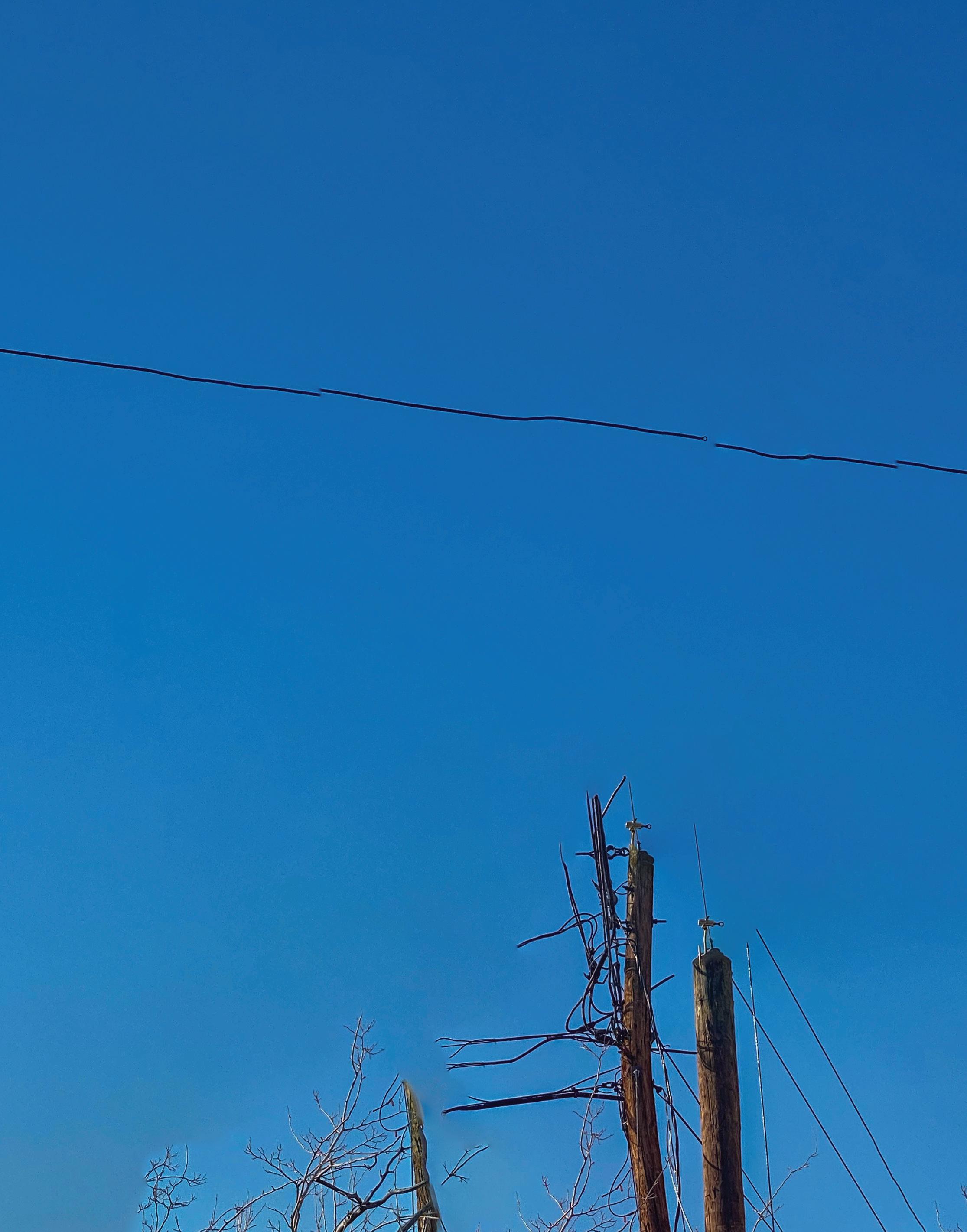

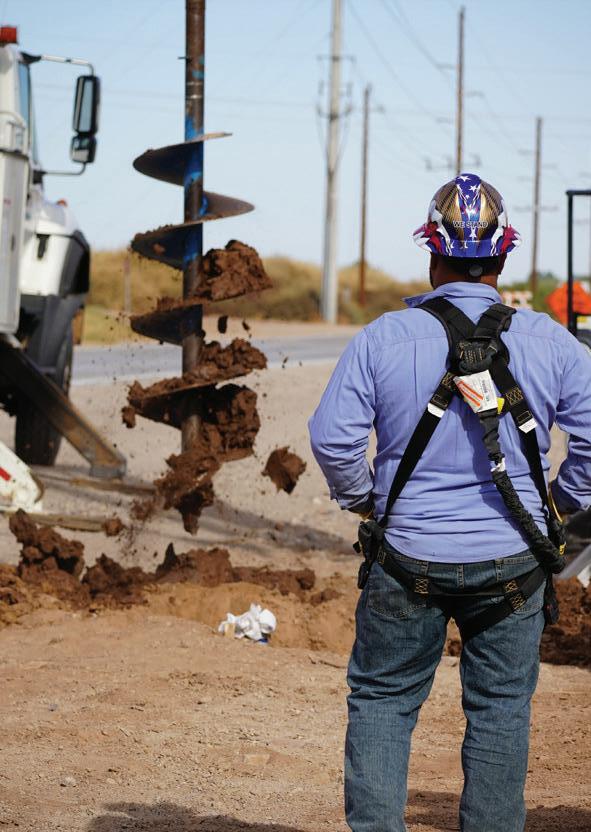



By Leanna Thesken
As the cold winter weather rolls in, make sure you are prepared to keep warm. Portable space heaters are a great option to beat frigid temperatures. Here are some tips and tricks to stay warm this winter.
Choosing the right space heater depends on the space you need to heat. Keeping your home safe is equally important.
• Determine your heating needs and size requirements.
» Finding the correct heater size is important. A space heater that is too large will consume more energy than needed. A space heater that is too small will not heat your space adequately. Find a space heater made for the approximate size of the room where it will be used. You need 10 watts of heating power for every square foot of floor space.
• Reduce the risk of fire and overheating with advanced safety features.
» Overheat protection detects when the heater reaches unsafe temperatures, shutting down to prevent overheating.
» Tip-over protection shuts off the unit if it is knocked over.

» Cool-touch housing is built with heat-resistant exteriors that eliminate the risk of burns from touching the unit.
According to the Consumer Product Safety Commission, space heaters cause more than 25,000 residential fires and more than 300 deaths each year. More than 6,000 Americans receive hospital emergency room care annually for burns from space heaters. Do not become a statistic. As the temperature drops and the use of space heaters rises, remember to follow all warnings.
• Read the manufacturer’s instructions and warning labels carefully.
• Ensure smoke alarms are properly working on every floor of your home.
• Check your space heater for a safety approval label from organizations such as Underwriters Laboratory (UL), Intertek (ETL) or the Canadian Standards Association (CSA).
• Scan the heater for any cracks, broken plugs or loose connections.
• Place the heater on a flat, smooth surface. Do not set it on furniture, tables, carpet or shelves.
• Avoid high-traffic areas, which increase the likelihood of the heater falling and overheating, potentially causing a fire.
• Keep the space heater at least 3 feet from flammable objects, such as bedding, curtains, furniture and papers.
• Never leave a space heater running unattended.
• Always plug a space heater directly into a wall outlet. Do not use an extension cord or power strip.
As you turn up the heat, make sure you do not turn up your utility bill. Save energy and money with these tips:
• Use a space heater’s timer feature and turn off the heater when not needed.
• Avoid heat loss by closing doors to rooms being heated.
• Check the wattage and size rating listed on the space heater and choose the right heater for the size of your room. n

How to calculate costs:
X Refer to your electricity bill to determine how much you pay for electricity per kilowatt-hour.
X Determine the amount of time the heater will be in use.
X Divide the heater’s wattage by 1,000. Multiply that number by the hours used per month, then multiply that number by your utility’s kilowatt-hour rate.
CONVECTION
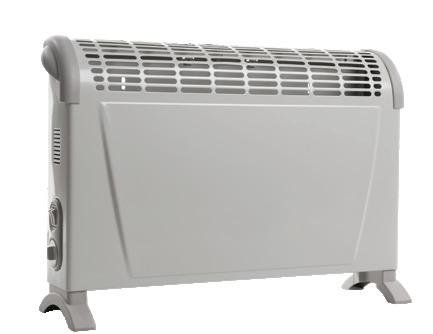
RADIANT/INFRARED

CERAMIC

OIL-FILLED

FAN SPACE HEATING

MICATHERMIC

PROS
• Capable of heating an entire room for an extended time.
• Cost-efficient.
• Cool-to-the-touch housing.
CONS
• Quick heat loss.
• Physical objects can block heat transfer.
• Mainly sends heat up to the ceiling.
PROS
• Physical objects do not block heat.
• Heat lasts even when the heater is turned off.
• Cool-to-the-touch housing.
CONS
• Heavy.
• One-directional heat.
• Needs physical objects to absorb the heat transfer. Fewer objects mean less heat.
PROS
• Compact and lightweight.
• Instant heat and heat oscillation.
• Heat still radiates after being turned off.
CONS
• Does not heat large spaces.
• Takes longer to heat up a room.
• Physical objects can block heat transfer.
PROS
• Does not have to continuously run to provide heat.
• Heat lasts even when the heater is turned off.
• Easy to move around.
CONS
• Cannot control the speed of the heat.
• The housing reaches hot temperatures.
• Does not heat large spaces.
PROS
• Compact and lightweight.
• Instant heat and heat oscillation.
• Cool-to-the-touch housing.
CONS
• Does not heat large spaces.
• Heat immediately stops being transferred after the heater is turned off.
• Physical objects can block heat transfer.
PROS
• Lightweight and portable.
• Instant heat.
• Silent operation.
CONS
• Does not heat large spaces.
• The design collects significant amounts of dust.
• Mainly sends heat up to the ceiling.

In December 2021, Mohave Electric Cooperative celebrated the one-year anniversary of breaking ground for our 100%, fiber-optic network. The project will help improve our electrical facilities and provide an opportunity for our members to subscribe to fast, reliable broadband, a critical need for the communities we serve.
The fiber network, considered the industry’s gold standard, is designed and built with 99.999% reliability. MEC has partnered with TWN Communications to offer fiber internet, digital phone, and TV streaming services.
MEC CEO Tyler Carlson said, “Like you, I hear so-called promises from other companies about new, improved internet. But you can rest assured we are keeping our promise. After less than one year of construction we have fiber built to the first phase of the project and members connecting to TWN’s fiber internet service. TWN is expanding service availability to more locations every day, and we will reach all of you with future project phases. Believe me we are just as anxious as you are for that day.”
The first residential member connected to TWN broadband in
June 2021, and the first business member, Mohave Shrine Club, connected to TWN’s broadband service in July.
On August 16, 2021 MEC was selected for the National Rural Electric Cooperative Association’s prestigious Cooperative Purpose Award. The award recognizes an electric cooperative who works with their members to make outstanding contributions which result in visible, lasting improvements to the quality of life and the purpose of the cooperative in the community.
September 15, 2021 marked the opening of TWN’s local storefront in Bullhead City to provide in-person, direct care to members. At a time when other companies are closing local stores, TWN is investing in our community and committed to serving MEC members. For information about TWN’s services or to sign up for service, members can visit the TWN storefront at 2020 Silvercreek Rd. #113D, Bullhead City, AZ 86442 or call 888-227-2095.
After just one year, more than 2,500 residential and business members can now subscribe to TWN services. MEC and TWN continue to build our fiber-optic network with future project phases that will expand TWN service opportunities for members to all areas of MEC’s service territory as the future construction phases are completed. n

















Follow Lewis and Clark’s epic 19th-century expedition along the Columbia and Snake Rivers aboard the newest riverboats in the region. Enjoy unique shore excursions, scenic landscapes, and talented onboard experts who bring the region to life.
Cruise Close To Home®


























































The Nimiipuu Language Program revitalizes language and culture for future generations
By Victoria Hampton
In North Central Idaho, the Lapwai School District on the Nez Perce Reservation is reshaping the way students interact with their culture and carry it forward to future generations.
“Our main mission is to meet the unique cultural needs of our students,” says Indian Education Coordinator Iris Chimburas. “It has a lot to do with the way our students are being taught. We bring
cultural relevance to the classroom.”
Since the late 1990s, Lapwai has offered the Nimiipuu Language Program to revive a language that was nearly lost. The language is taught through more than 300 documented Nimiipuu (neeMEE-poo) stories, which offer cultural relevance and moral guidance deeply rooted in the place the Nez Perce call home.
them to be our Nez Perce young adults,” Iris says of the language teachers.
The program started with six elders fluent in Nimiipuu assisting the language staff. Today, only two of the original elders remain: Bessie Scott and Florene Davis.
Thanks to the elders, the proficiency of the language teachers has grown.
At times, there was only one part-time Nimiipuu language teacher. Now, there are six teachers: five in the Lapwai School District and one in the Kamiah School
“Some tribes have no speakers left,” says Nimiipuu Language Team Leader Thomas Gregory, who grew up in Lapwai. “We’re fortunate we still have some speakers. If you aren’t speaking it, it will go away. When I was in high school, there was no way to learn the language.”
Now, students are learning the language and taking it home, he says.
In 2015, the Nimiipuu Language Program staff visited the Umatilla Tribe in Pendleton, Oregon, for a three-day workshop with Salish School of Spokane. The staff shared its teaching method, which involved starting with pictures instead of written words. The style harkens back to the way tribes learned their languages and passed down stories.
“It totally changed how we taught, fostering the natural learning process: recognition, comprehension and after that is two stages of production,” Thomas says. “The first time we saw the curriculum it didn’t seem like much, but it’s how you teach it.”

“They are preparing our future leaders—training our students and teaching District. it’s
The classroom isn’t filled with thick
textbooks, a white board covered in conjugated verbs, and pencil and paper for students to vigorously copy what is written.
Instead, students are shown pictures, and they repeat words and phrases while learning Nimiipuu stories.
“The old curriculum has its use in some situations when you are trying to teach a writing system,” Thomas says. “It works a lot better when you talk to each other.”


From there, students work on phrases using imagery. They move on to questions,

the differences between sounds and words, and adjectives.
This helps students start to recognize the practical use of the language, Thomas says.
“I don’t usually write it down at first at all,” he says. “I’ll pull in the picture, repeat as many times as they can and associate the word with that language.”
Teachers incorporate image-focused activities and games to improve comprehension and create a fun learning environment.
Thomas then says all the words learned that day and has students repeat them. He shows students a picture and says two words. Students choose which one is correct. Thomas repeats this until the class understands the words, focusing on 10 images a lesson, with two lessons a week for beginner levels.
As students get older, they start learning grammar, including singular plural nouns, points of view, tenses, suffixes and prefixes, with the guidance of imagery and the written language.
“After we took the training, we really wanted to make it more of our own using some of those same techniques,” says Angel Sobotta, Nimiipuu language program coordinator.
That’s where the more than 300 Nimiipuu stories come alive in the classroom. The language staff has adapted the stories for beginner, intermediate and advanced learning.
“Our culture is in our stories,” Thomas says, noting they often are based on real historic sites.
As students become more confident speaking the language, Thomas has noticed their families and friends start to speak the language, even communicating on Facebook and texting in Nimiipuu.
“I wouldn’t speak it growing up at home, but when I got into middle school I got really interested and took it every year since seventh grade,” says Armani Bisbee, a senior at Lapwai High School. “I really enjoyed it in class and nowadays I’m trying to speak more often out of school.”
Armani and his mother started learning



In the Nez Perce story támsoy káa ‘alatálo, readers are told that when Yellow Jacket and Ant, opposite page, would not stop fighting, Coyote turned them to into stone. The formation pictured above can be seen along Clearwater River above U.S. Highway 12 and is part of Nez Perce National Historical Park. The text for the illustration reads: ku’swecéen, támsoy káa ‘alatálo píiwepeke’yke.
Thus for that reason, Ant and Yellow Jacket fought each other. píiwepeke’yke káa píiwepeke’yke piswéewecet. They fought and they fought because of the rock.
Hear the story at https://bit.ly/3sbOp5K. Learn more about the language program at nimipuutimt.org.
from each other. Two years ago, his mom took the Nimiipuu language class at Northwest Indian College in Lapwai.
“She would always ask me questions, or I would help her speak it,” Armani says. “When people ask me what a word means or how to say it, I am happy that other people are learning and know that I know about the language.”
Armani continues to improve his speaking skills and wants to learn to write the language. He says the stories help him connect to his culture.
“I enjoyed that there is much to learn and I get to learn about my heritage,” he says.
High school students such as Armani can apply their studies of Nimiipuu to their foreign language requirement at LewisClark State College.
Language teachers know firsthand the
ripple effect the language program has had on the community but say it will only remain successful if the language and stories continue to be passed from generation to generation.
“We never have enough time with them,” Thomas says. “All of a sudden they are seniors. I hope they stay with it. I give them as many tools as I can to stick with it.”
For the Nimiipuu language teachers, the program continues to evolve thanks to their elders and each other.
“We’re still learning ourselves,” Thomas says. “I say we will all know how good of a job we’ve done when I am the old man sitting in the corner watching you teach the language.” n
More information about the Nez Perce language preservations follows on page 12.

By Victoria Hampton
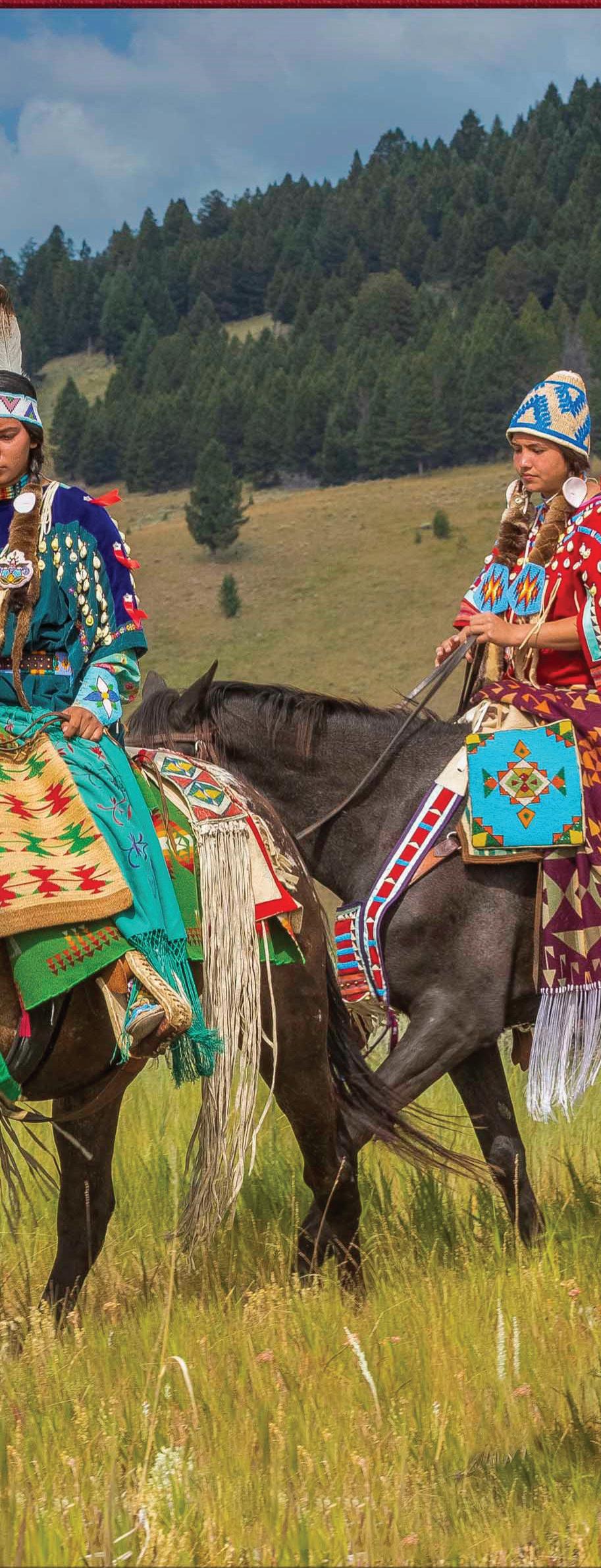
Along Clearwater River in North Central Idaho, the landscape comes alive with stories.
The arched rock formation is where Ant and Yellowjacket were turned to stone. Coyote’s fishnet is etched into the hillside. The Heart of the Monster rests along the banks.
When Nez Perce Language Program
“ The language ties directly to the land, and so we form that connection to that land and language within the story.
—ANGEL SOBOTTA
Coordinator Angel Sobotta takes her middle school students to these landmarks, she isn’t simply showing them geographic marvels. She’s sharing stories that bring new life to her culture and language.
Angel has dedicated her career to teaching the Nimiipuu (nee-MEE-poo) language at Lapwai School District in Lapwai, Idaho. The Nimiipuu—also known as the Nez Perce people—are deeply rooted in the landscape they have called home for millennia.
Rich in knowledge and moral values, the oral retellings of their stories preserve the language and traditions of the tribe.
“The language ties directly to the land, and so we form that connection to that land and language within the story,” Angel says.
By sharing stories in the Nimiipuu language, students and teachers are reclaiming their cultural identity for future generations.
Growing up in Lapwai, Angel knew only a few Nimiipuu words spoken by her family and friends. It wasn’t until third grade she felt connected to her language, when she received some Nimiipuu classes.
“I was so fascinated with those colors, numbers, animals at that age,” Angel says. “I was good at it, and it made me feel smart. It built my self-esteem to know I was excelling in my own language. Once you put meaning behind what you’re learning, it means so much more.”
Although this was the only formal Nimiipuu language learning Angel received during her time at Lapwai School District, it stuck with her.
After she graduated from high school,
Angel attended Washington State University in Pullman and then transferred to University of Washington in Seattle. After college, she worked in the city at Indian Heritage High School teaching a culture class.
“I really started getting invested in my culture and the history and the stories and language,” Angel says. “Everything became more appealing to me as I matured.”
She created a Nimiipuu club while living in Seattle to learn and share the language and culture. But for Angel to truly revive her language, she needed to return to where her culture was alive all around her—from traditions to the landmarks that shaped her ancestors.
“Everything was gray and so hard all around me,” Angel says. “I wanted to get back and study my language, be with my grandmothers before they passed away. I wanted to get an Appaloosa horse and marry a Nez Perce man.”
After 10 years away from home, Angel returned in 1997 and began her journey of learning and teaching the Nimiipuu language. She took a part-time position with the Nimiipuu Tribe Cultural Resource Program to create a language curriculum and took Nimiipuu language classes at Lewis-Clark State College.
Angel and co-workers Harold Crook and Ann McCormick had guidance from the Nez Perce Dictionary and the college’s language classes, but they still needed to learn how the language was traditionally spoken and the meaning behind the words and phrases they were learning.
“We have 300-plus of our own stories,”

Not many people can say their family helped save their language, but when 13-year-old Skylin Parrish opens her dictionary, her family’s history unfolds.
The Nez Perce Dictionary holds the written language of the North Central Idaho tribe. In 1960, UC Berkeley Linguistics PhD student Haruo Aoki visited the Nimiipuu Tribe, also known as the Nez Perce Tribe, to document its oral language.
Nimiipuu elders who were fluent and proficient in the language assisted Haruo.
For Skylin and her 11-year-old brother, Sonny, their great-great-grandparents Wallace and Ida Wheeler are memorialized in the dictionary for contributing to its creation.
The 12-year project included writings and recordings of the tribe’s language and stories compiled into a linguistic document.
“It was written in the language and written in English and then recorded,” says Nimiipuu Language Program Coordinator Angel Sobotta.
In 1994, the Nez Perce Dictionary was published. The dictionary and oral recordings preserved the language and supported development of the Nimiipuu Language Program at Lapwai School District.
Nimiipuu is traditionally a spoken language rich with storytelling passed down from generation to generation. With the rise of Westernized culture and education, the language started to disappear.
“Some of my ancestors couldn’t speak the language and had to learn English,” Skylin says.
That was the case for her great-greatgrandfather. In first grade, Wallace was no longer allowed to publicly speak his language. He began learning English at a nearby school.
The seemingly small deviation in his education had drastic effects on his family. Future generations no longer reached fluency.
“His children weren’t taught, and my mom learned a little bit,” says LoriLynn Parrish, Skylin’s mother. “When I was young, I learned a little in Head Start and then not until high school.”
This is the first time in five generations LoriLynn’s family has been allowed to learn and speak Nimiipuu throughout their public school education.
During his final years, Wallace lived with Skylin and Sonny. He introduced them to the language, reigniting a generation of his family speaking the language at home.
“I think that for me, and maybe for all tribal people, the language is healing,” LoriLynn says.
She notes how special it was for her children to spend time with Wallace—one of the last remaining fluent Nimiipuu speakers.
“I hope that they will become fluent and, because of the language programs, that we will hopefully never lose our language, but be able to take it back,” LoriLynn says.
Skylin is proud of her ability to have a conversation in Nimiipuu.
“I speak it with some of my friends at school,” she says. “I want to keep doing it until I am fluent with it.”
Angel says. “They were documented and written in the language in the 1960s. We have oral recordings to study the old language and put them into the curriculum. I asked myself, ‘How can I build the curriculum, and what are we going to do when our elders are gone?’”
The team sought the help of six tribal elders who spoke Nimiipuu to create a language program for Lapwai School District.
“It was said at the time that we had 80-plus speakers,” Angel says. “It always felt like only a handful of speakers.”
Angel says there is meaning within every story, and it can be lost when translated into English. The elders helped the teachers read between the lines and better understand the stories.
“People think you can just grab a dictionary, yet you need to know what those sounds represent,” says Thomas Gregory, Nimiipuu language team leader. “That’s where we have to learn as much as we can. It’s a challenging race against time. Our elders aren’t going to be with us forever.”
Reviving the Language
Through guidance from the elders—along with the written and oral recordings of the tribe’s stories—the Nimiipuu Language Program was created.
“None of us are fluent,” Angel says of the language teachers. “The more appropriate word to use is proficient.”
In fall 1997, the language curriculum was launched at Lapwai Elementary School. Today, it is taught by six teachers throughout the district and in Kamiah.
Students start learning Nimiipuu words in preschool. Language classes become part of the weekly curriculum in grades 6-12.
Storytelling is at the core of Angel’s language instruction. With pictures and oral repetition, she tells one story a week in the classroom, reconnecting students to their language and the land that has shaped the generations before them.
“I am trying to teach them the place,” she says. “I want them to know origins of the sweathouse. It’s the remembering place. When you know the name, it becomes so much more powerful.”

Setting the Stage
Angel received her master’s from the College of Education at University of Idaho, in 2013, focusing on learning language through stories. As her final project, she created a play of the Heart of the Monster creation story.
“Angel has a way of teaching the language and telling the stories that helps draw the students in,” says LoriLynn Parrish, Lapwai School District homeschool liaison and mother of students Skylin and Sonny. “She can be very animated when telling the stories, which helps students and myself remember more of the story.”
Angel is continuing her studies by earning her doctorate from University of Idaho.
“I am investigating the indigenous knowledge within the stories and language to build back our relationship to these places and story sites,” she says.
Through their continuous work with the elders, Angel and her team gains a deeper understanding of many words and stories in their language.
“Our staff and elders are researching and looking at pieces of the language,” Angel says. “That is where some of the indigenous knowledge jumps out.”
The Language and the Land In 2021, Angel started taking middle school
students on field trips to sites throughout the Nimiipuu land. Students study the stories and images before the trips.
“There are a lot of things that come into effect that were passed down through generations that are really hard to show in a classroom,” says Indian Education Coordinator Iris Chimburas, who secured funding for two vans to transport students.
At Nimiipuu sites, students retell the stories they have learned and play games in the language associated with the place.
“That’s one of the richest things the language program is doing for the kids right now,” Angel says. “The kids now know what to call the place. They know the story and how to locate it.”
After teaching for 24 years and dealing with the struggles of reviving her language, Angel says the field trips have reinvigorated her work.
A thank-you note from her niece, seventh grader Davi Jo Whitman, reads, “You understand us more than other people can.”
“Those things keep you going,” Angel says. “They feed the soul so that you can continue doing the soul work.”
Angel and the language program team have banded together to create something bigger than themselves that won’t be lost by the passing of time.
“We’re dropping those seeds and we’ll see what can blossom in the future,” Angel says. n

Nestled along the banks of Clearwater River in Idaho, the Heart of the Monster rests. Now docile amongst the rolling hills, its significance lies in the creation story of the Nimiipuu, also known as the Nez Perce people.
Heart of the Monster is one of the sacred Nimiipuu story sites that can be visited along Highway 12 near Kamiah, Idaho. To view the full story, watch Angel Sabotta’s Heart of the Monster play on the Ruralite website, https:// www.ruralite.com/heart-of-the-monster.
ABOUT THE SERIES: Pioneer Utility Resources, publisher of this magazine, is taking readers on a yearlong journey, The Learning Curve, highlighting success stories in rural education in challenging times. The series receives support from the M.J. Murdock Charitable Trust, a private nonprofit foundation serving nonprofits across the Pacific Northwest.


Healing Chickpea and Rice Bowl
5 cups water
5 ginger turmeric tea bags
13.5-ounce can full-fat coconut milk
3 limes, juiced
1 lime, cut into six wedges (for garnish)
1½ teaspoons Asian fish sauce
1 teaspoon sea salt
2 15-ounce cans chickpeas, drained and rinsed
2 cups cooked rice
½ bunch cilantro, chopped
Sriracha or spicy Asian chili sauce
In a small saucepan, bring water to a boil. Add teabags. After they are fully immersed, add coconut milk. Put a lid on the pot and steep for 10 minutes. Squeeze the tea bags into the pot and discard them.
Stir lime juice, fish sauce and salt into the tea/coconut milk broth. Keep at a low simmer.
In a blender, combine 1 cup of chickpeas and a few ladlefuls of broth. Once it is blended smooth, add it back to the broth. Stir.
Pile chickpeas and rice into shallow bowls. Ladle broth around them.

Garnish with chopped cilantro and Sriracha to taste. Serve with lime wedges.

4 russet potatoes, scrubbed
1 tablespoon olive oil
5 cups vegetable, beef or chicken stock
1½ pounds beets, cooked, peeled, cut into chunks
2 cups sauerkraut
Heat oven to 400 F.
8 ounces sour cream or cashew cream
2 to 3 teaspoons horseradish, freshly grated or prepared ½ cup chopped fresh dill, packed
Salt and pepper, to taste
Rub the potatoes with olive oil and place on a baking sheet. Sprinkle with coarse salt. With a sharp knife, cut a 2-inch to 3-inch slit in the top of each potato. Roast until a knife inserted into the center offers no resistance and the potatoes give a little. This may take 40 minutes to an hour. Bring the stock to a simmer in a large saucepan. Pulse beets 12 to 15 times in a food processor to a fine, irregular mince. Stir the beets into the stock. Taste the broth. Add more salt and freshly cracked black pepper, if needed.
Squeeze out most of the brine from the sauerkraut. Warm the sauerkraut in a microwave oven or small saucepan. Stir together the sour cream or cashew sour cream, horseradish and most of the dill, reserving some for garnish.
Place each potato in its own wide bowl and crack it open along its slit. Ladle the hot beets and broth over each potato. Place a big dollop of herbed sour cream on the potato. Pile on the sauerkraut. Garnish with the remaining dill. Serve hot.
5 tablespoons olive oil, plus more for garnish
1 small head white cauliflower, chopped
1 small celeriac (celery root), peeled and chopped
1 onion, peeled and chopped
2 large russet potatoes, peeled and chopped
1 bulb fennel, sliced
2 cloves garlic, minced
5 sprigs fresh thyme, plus more for garnish
6 cups vegetable or chicken stock
1½ teaspoons salt
½ teaspoon black pepper
Place the olive oil in a 5-quart pan or Dutch oven over medium heat. Add cauliflower, celeriac, onion, potatoes, fennel, garlic and thyme. Stir. Cover and cook over medium heat for about 10 minutes, until the vegetables begin to soften, stirring frequently.
Add stock, salt and pepper to the pan. Stir. Cover and simmer, stirring every 5 minutes until the vegetables are fully tender and a fork can be easily inserted, about 20 to 25 minutes.
Blend the vegetables with an immersion blender or in a blender or food processor until completely smooth. If the soup seems too thick, add up to a cup of water so it becomes smooth and creamy.
Adjust seasoning to taste. Garnish with a swirl of olive oil and additional thyme.
1 cup cashew pieces, plus more for garnish
5 tablespoons olive oil, plus more for garnish
1½ pounds carrots, peeled and chopped
1 onion, peeled and chopped
3 tablespoons fresh ginger, peeled and minced
6 cups water, vegetable stock or chicken stock
1½ teaspoons salt
½ teaspoon black pepper
Place the cashews in a small bowl and cover with boiling water. Set aside for one hour, then drain well.
Place the olive oil in a 5-quart pan or Dutch oven over medium heat. Add the drained cashews, carrot and ginger. Stir. Cover and cook over medium heat for about 10 minutes, until the vegetables begin to soften, stirring frequently.
Add the water or stock, salt and pepper to the pan. Stir. Cover and simmer, stirring after 10 minutes, until the carrots are fully tender when a fork is inserted, about 20 minutes.
Blend the vegetables and broth with an immersion blender or in a blender or food processor until it is completely smooth. If the soup seems too thick, add up to a cup of water so it becomes smooth and creamy. Adjust seasoning to taste. Garnish with a few finely chopped cashews and a swirl of olive oil.
1 large butternut squash
5 tablespoons olive oil, plus more for garnish
1 onion, peeled and chopped
6 cups water, vegetable stock or chicken stock
Heat oven to 425 F.
1½ teaspoons salt
1 bunch kale, ribs removed, chopped
½ teaspoon black pepper
6 strips bacon, cut into halfinch pieces
Slice the squash in half and scoop out the seeds. Place the squash cut side down on an oiled baking sheet. Roast for 30 minutes until the flesh is softened throughout. Remove from the oven. When it is cool enough to touch, scoop the flesh out of the skin with a large spoon. Set aside.
In a 5-quart pan or Dutch oven, cook the bacon over medium heat, stirring occasionally, until it is crisp, about 5 minutes. Remove bacon from the pan and set aside.
Add onion to the fat in the pan. Cook, stirring often, until softened. Add the squash, water or stock and salt. Cover and simmer for 20 minutes.
Blend the vegetables and broth with an immersion blender or in a blender or food processor until completely smooth. If you use a blender or food processor, return the soup to the pan. If the soup seems too thick, add up to a cup of water so it becomes smooth and creamy.
Stir the chopped kale into the pot. Cook for 10 minutes. Adjust seasoning to taste. Serve in bowls. Garnish with crumbled bacon and a swirl of olive oil.
I am looking for a copy of “Centennial History of Oregon 1811-1911,” Volume 1, published in 1912. Willing to pay reasonable price plus shipping for this book in good condition.
Roger LeMaster
3095 N. Second St. Baker City, OR 97814 rogerdianelemaster@yahoo.com
Looking for empty plastic livestock feed bags for projects and any free older sewing machines for restorations. Will pick up if in local area.
Tanya P.O. Box 270693 Susanville, CA 96127
My 7-year-old daughter and I have been making vintage ‘50s style aprons, and cute felted animals to sell next summer to raise money for our local women’s homeless shelters. If anyone has any extra cotton fabric, thread, rickrack, double-fold bias tape, craft felt or wool felt lying around, we would love to take them off your hands. We don’t mind paying for postage. Thank you so much in advance for your help. We appreciate it more than you know. You can contact me at natalijeanine@gmail.com, or just send the items to us if you’d prefer.
Ava and Natalie Boothe 35760 Highway 22 Hebo, OR 97122
I am looking for a few leather scraps of any color or shape. Thank you.
Pam Keeton
P.O. Box 1120 Sisters, OR 97759
If you have any extra fabric and patterns of any kind and any age. I would greatly appreciate it to make clothes. Thank you.
Jeanmarie Warren
P. O. Box 345 Elgin, Oregon 97827
My mom will be 105 years old at the end of January. She is a spunky lady with a very sharp mind and loves to play
games that are competitive—she loves to win, too. She recently had to move to an assisted living home after living in her own home for more than 70 years. Moving from her home has been a big transition. She sometimes feels lonesome. I know it would help mom immensely if she received birthday cards from caring readers. I would so appreciate it, and I know mom would too. Thanks in advance for your thoughtfulness. Send cards/notes to: Eleanor Thompson, Jennings McCall Assisted Living, 2221 Oak St., Forest Grove, OR 97116.
Jan B
Vernonia, Oregon
My mom, Barbara, turns 80 at the end of January. She has managed to survive two separate brain tumor surgeries in the last four years. She would be shocked beyond belief if folks would be so kind as to send her a birthday card. Please send to: Barbara Raines, 1970 Smith Flat Road, Placerville, CA 95667. Thank you.
Terry Sibel Redmond, OR
If you have any unwanted movies in CD format, I would love them. Thanks in advance.
Rosalie Ferry 109 Raven Lane Careywood, ID 83809-9711
In July 1980, I would drive from Delta Junction to Fairbanks to attend an MS meeting that used hypnosis given by Dorothy Langworthy. Her cassette tape help alleviate pain and stress. I have since lost this recording and hope someone out there remembers this class or has a copy of this recording. I will reimburse to copy and send.
Deborah Bedey
224 S. Fifth St. Hamilton, MT 59840
Have real wine corks, not the imitation ones. Just pay postage.
Ed B.
6611 White Eagle Drive Pahrump, NV 89061
I never imagined my request for buttons would have resulted in so many buttons needing a good home. You sent me buttons that belonged to moms and grandmas, personal buttons and yard sale buttons. What a treasure trove of information. It was like Christmas everyday. My button club was in awe. Many buttons were real treasures and will be framed. So many will be used for button craft projects as well. I treasure your kindness. God bless.
Charlotte Beaudry Trout Creek, MT
Send your request—with no attachments—to readerexchange@ ruralite.org or mail to Reader Exchange, 5625 NE Elam Young Parkway, Suite 100, Hillsboro, OR 97124. Fill in the subject line with Reader Exchange. Acceptance, scheduling and editing are at the editor’s discretion. Single requests only, please. No duplicates. Submissions are handled on a first-come, first-served basis and as space allows. We cannot honor every request.
Please affirm you have authorization from all appropriate parties before submitting. By submitting, you indemnify Reader Exchange, Pioneer Utility Resources, Inc., its officers, directors, employees, utility clients and insurers from all legal liability incurred by the publication of information.
We no longer accept pen pal requests. You may submit a pen pal request as a Marketplace ad. Marketplace pricing applies. When submitting a milestone request, send at least two months before the milestone. Phone numbers will not be published. Email addresses will be published if part of the ad, but the request must include a postal address. Request must include the name and address of the electric utility that provides your magazine.

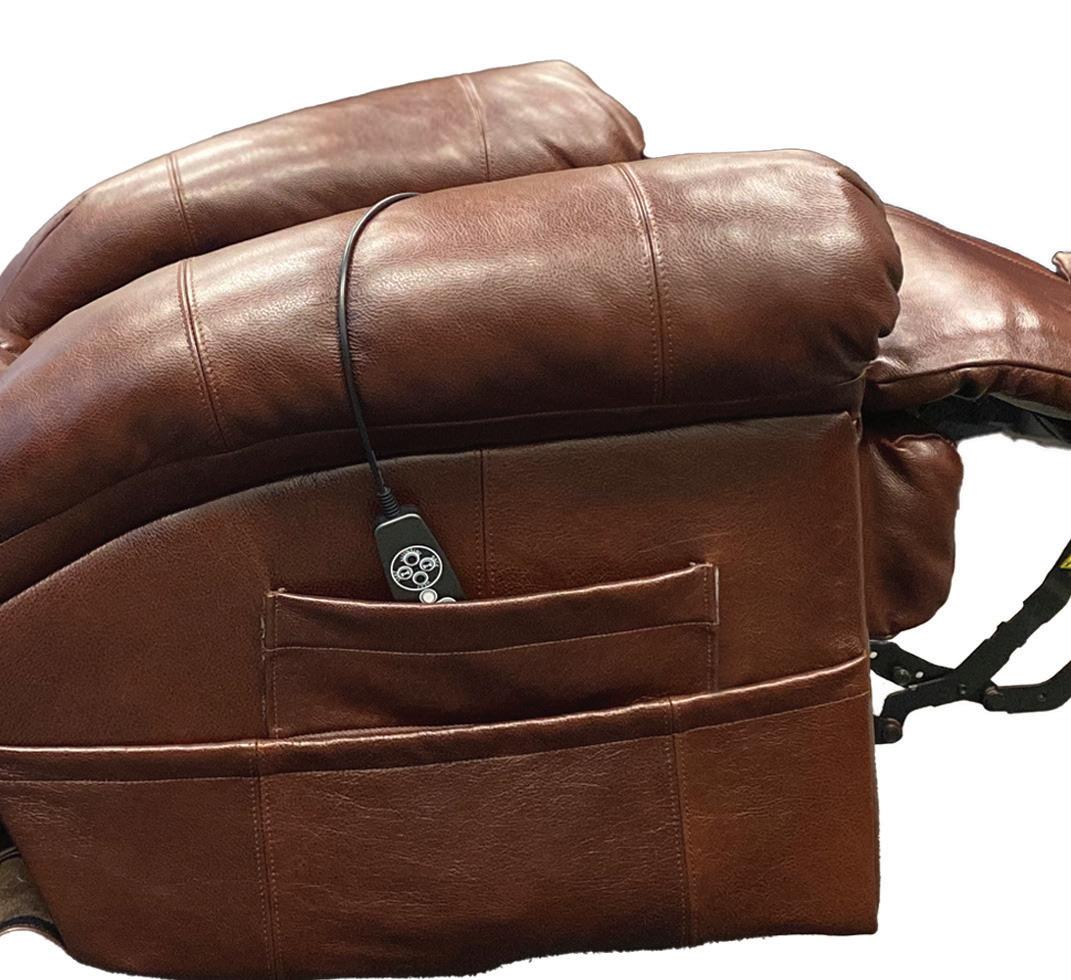


You can’t always lie down in bed and sleep. Heartburn, cardiac problems, hip or back aches –and dozens of other ailments and worries. Those are the nights you’d give anything for a comfortable chair to sleep in: one that reclines to exactly the right degree, raises your feet and legs just where you want them, supports your head and shoulders properly, and operates at the touch of a button.
Our Perfect Sleep Chair® does all that and more. More than a chair or recliner, it’s designed to provide total comfort. Choose your preferred heat and massage settings, for hours of soothing relaxation. Reading or watching TV? Our chair’s recline technology allows you to pause the chair in an infinite number of settings. And best of all, it features a powerful lift mechanism that tilts the entire chair forward, making it easy to stand. You’ll love the other benefits, too. It helps with correct spinal alignment and promotes back pressure relief, to
prevent back and muscle pain. The overstuffed, oversized biscuit style back and unique seat design will cradle you in comfort. Generously filled, wide armrests provide enhanced arm support when sitting or reclining. It even has a battery backup in case of a power outage.

White glove delivery included in shipping charge. Professionals will deliver the chair to the exact spot in your home where you want it, unpack it, inspect it, test it, position it, and even carry the packaging away! You get your choice of Genuine Italian Leather, stain and water repellent custom-manufactured DuraLux™ with the classic leather look or plush MicroLux™ microfiber in a variety of colors to fit any decor. New Chestnut color only available in Genuine Italian Leather. Call now!





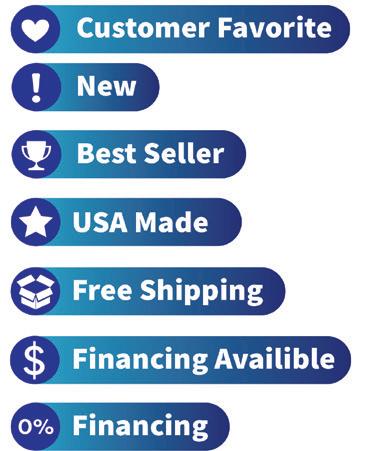






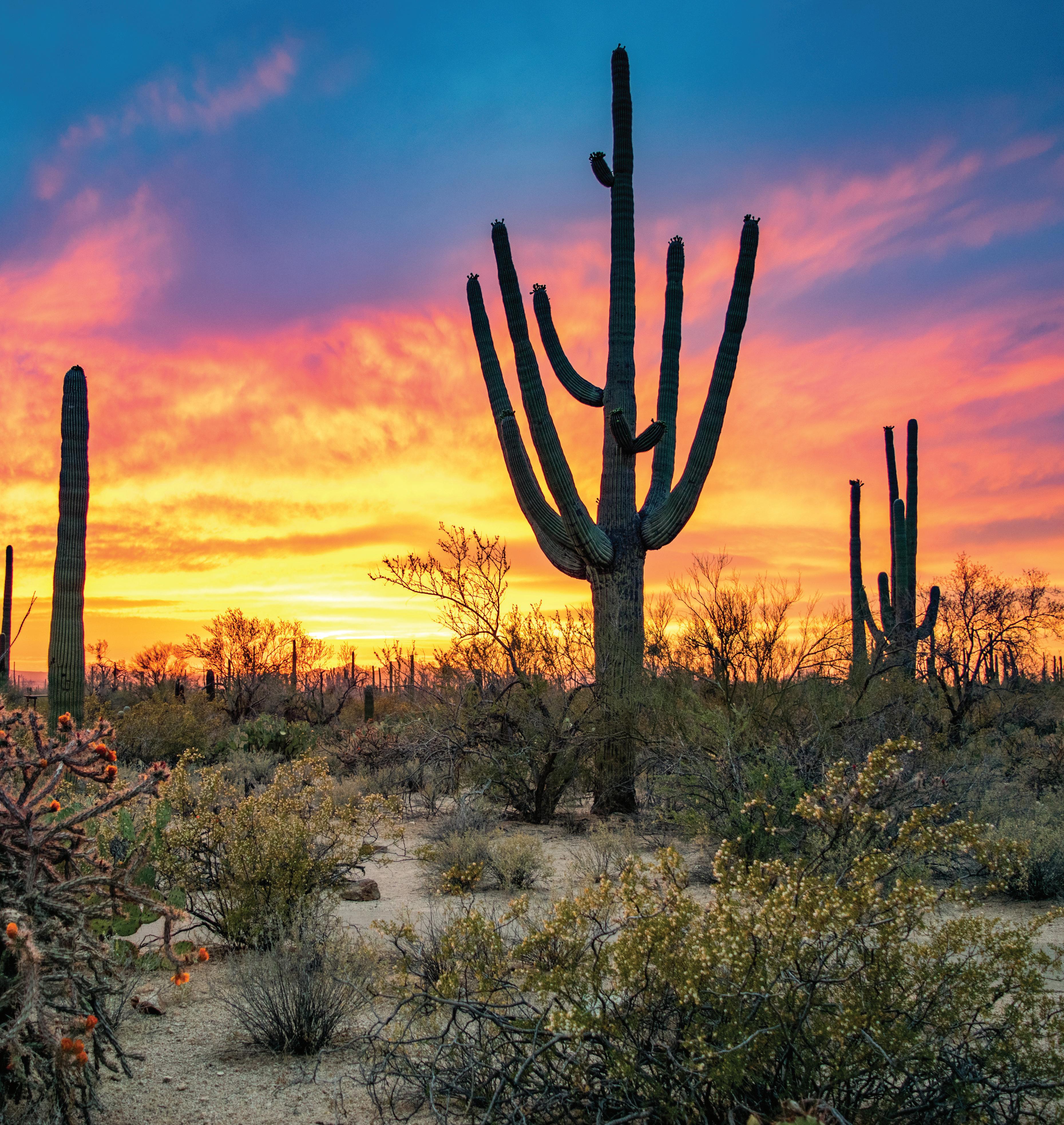
Behold the giant saguaros and their skywardreaching arms near Tucson, Arizona, when visiting Saguaro National Park.
It
Saguaros normally grow 40 feet high, and can branch out many arms. Great hikes in the national park include the Freeman Homestead Trail, a 1- mile path to an old homestead. If staying in the car, consider Cactus Forest Drive, an 8mile one-way loop.
In the 1920s, members of the Natural History Society of the University of Arizona sought to create a preserve for the iconic saguaro. Eventually, a Tucson newspaper thought a local national monument would be good for business and joined the cause. Saguaro became a national monument in 1933.
Saguaro went from national monument to national park statusin 1994 after congressional approval. At the same time, the 15,360acre Tuscon Mountain Park was added to Saguaro, bringing the full park to more than 90,000 acres.
Much like the United States, Saguaro national park holds a census every 10 years. In the citizen science effort staff and volunteers document saguaros to track plant life. The 2010 census estimated the park held about 1.9 million saguaros.
Entrance to Saguaro National Park is $25 per vehicle for a weekly pass does with its count of residents, $20 for ,a motorcycle and $15 per person on foot. For more information, and for updated local health guidelines, call 520-733-5153 or visit www.nps.gov/ sagu.

a rechargeable hearing aid
The answer: Although tremendous strides have been made in Hearing Aid Technology, those cost reductions have not been passed on to you. Until now...
The MDHearingAid® VOLT+ uses the same kind of technology incorporated into hearing aids that cost thousands more at a small fraction of the price.
Over 600,000 satisfed MDHearingAid customers agree: High-quality, FDA-registered rechargeable hearing aids don’t have to cost a fortune. MDHearingAid is a medical-grade, digital, rechargeable hearing aid offering sophistication and high performance; and works right out of the box with no time-consuming “adjustment” appointments. Now that you know... why pay more?
















































I have friends, some winners of the coveted Pulitzer Prize, who for better or worse are forever connected to one photograph, one moment.
Eddie Adams’ controversial photograph of a 1968 street execution during the Vietnam War is a prime example of a Pulitzer moment and a “signature” photograph—a haunting picture Adams could never distance himself from.
An iconic photograph made in 1936 of Florence Owens Thompson, titled Migrant Mother, became Dorthea Lange’s signature image.
Each of us have likely made a signature photograph—a picture we feel defines the way we see the world, or best represents what we find interesting or beautiful.
Your signature photo may be a breathtaking scene of a special place or a portrait of a stranger with a face etched by time. Perhaps it is a family photo that captures a memorable time, or a self-portrait that represents how you feel or see yourself.
I have several signature photographs. Perhaps my most popular is a picture titled “Baby Contest”—a scene captured on a sweltering Fourth of July in a tiny Kansas town in 1979.
Most of my favorite signature photographs are not loud, action-packed captures from sporting events or conflicts, but subtle, quiet relationship stories of love, humor and hope.
Too often in this social media age, I fear we associate a “good” photo by the number of online likes we receive.
My longtime friend Pete Souza—a great photographer who captured incredible and memorable moments during his tenure in the White House documenting presidents Ronald Reagan and Barack Obama—can take a picture of his foot and easily garner 50,000 likes.
This proves the number of likes isn’t always a good judge of a photograph’s quality as much as an individual’s popularity.
One way to choose a signature photograph you have taken is to ask yourself: “If I had to choose one photograph I’ve made to be enlarged and displayed at my funeral or printed on a program, what would it be?”
Another barometer might be how a particular photograph makes you feel when you view it. Like songs, there are pictures that lift our spirits and wrap us in hope. n

captured special moments for more than half a century, sharing photo tips and perspectives on life with readers. For more of his writings, visit www.greatpicturehunt.com and bridgesandangels.wordpress.com.
Look through your archives and see if you can identify a few images that best represent how you see the world or define you as a photographer—your “signature” pictures. Then, write a few lines (or more) sharing how you feel about these images.
Maybe this exercise will be the impetus to try and make such a photograph. This can be a deep dive into personal evaluation. Email your best image with caption information and explain how it affects you to GPH@pur. coop. We may share the best submissions on our website and social media channels.














































































































The very best hunting knives possess a perfect balance of form and function. They’re carefully constructed from fine materials, but also have that little something extra to connect the owner with nature.
If you’re on the hunt for a knife that combines impeccable craftsmanship with a sense of wonder, the $79 Huntsman Blade is the trophy you’re looking for.
The blade is full tang, meaning it doesn’t stop at the handle but extends to the length of the grip for the ultimate in strength. The blade is made from 420 surgical steel, famed for its sharpness and its resistance to corrosion.
The handle is made from genuine natural bone, and features decorative wood spacers and a hand-carved motif of two overlapping feathers— a reminder for you to respect and connect with the natural world.
This fusion of substance and style can garner a high price tag out in the marketplace. In fact, we found full tang, stainless steel blades with bone handles in excess of $2,000. Well, that won’t cut it around here. We have mastered the hunt for the best deal, and in turn pass the spoils on to our customers. Also, receive a genuine leather sheath FREE when you purchase the Huntsman Blade. Your satisfaction is 100% guaranteed. Feel the knife in your hands, wear it on your hip, inspect the impeccable craftsmanship. If you don’t feel like we cut you a fair deal, send it back within 30 days for a complete refund of the item price.
Limited Reserves. A deal like this won’t last long. We have only 1120 Huntsman Blades for this ad only. Don’t let this beauty slip through your fingers. Call today!

What Stauer Clients Are Saying About Our Knives
“This knife is beautiful!”
— J., La Crescent, MN
“The feel of this knife is unbelievable...this is an incredibly fine instrument.”
— H., Arvada, CO
Huntsman Blade $249* Offer Code Price Only $79 + S&P Save $170 1-800-333-2045
Your Insider Offer Code: HUK706-03 You must use the insider offer code to get our special price.


W., Ste 155, Dept. HUK706-03 Burnsville, Minnesota 55337 www.stauer.com
*Discount is only for customers who use the offer code versus the listed original Stauer.com price. California residents please call 1-800-333-2045 regarding Proposition 65 regulations before purchasing this product. Rating of A+
• 12” overall length; 6 ¹⁄2” stainless steel full tang blade • Genuine bone handle with brass hand guard & bolsters • Includes genuine leather sheath



Mohave Electric Cooperative welcomed Rick Hernandez last November as the new human resources manager. Rick brings over a decade of experience to MEC.
For the past eleven years, Rick worked for a sourcing agency as regional manager overseeing operations for Arizona and Nevada through interviewing and hiring. MEC’s administrative office has previously contracted reception & other hiring through his sourcing agency.
“MEC has a great reputation, with ties to the community. This is a great opportunity that I couldn’t pass up to work closely with members and with team-orientated employees,” says Rick Hernandez.
Community is a priority for Rick. For twenty-five years, he has coached youth and travel basketball. Rick has lived in Bullhead City for the last seventeen years where he currently resides with his fiancé.
Rick has human resources certification from Villanova University in Pennsylvania.
Mohave Electric Cooperative also welcomed Jonathan Martell as chief operating officer in December. Jonathan has a vast amount of experience, with more than thirty years in energy transmission and distribution facilities.
For the past five years, Jonathan has worked for Arizona Electric Power Cooperative (AEPCO) as executive director of energy service. He was responsible for overseeing all energy and fuel procurement along with member and customer billing, while managing the resource planning team, including service to MEC.
“Jonathan will be a great asset to our members through his demonstrated success of senior management, leadership, and strategic business planning. His negotiation of lower rates of railroad transportation contracts at AEPCO showcases the dedication our members will appreciate,” says chief executive officer, Tyler Carlson.
Jonathan has succession management leadership certification from Pima Community College and an A.S. degree in Electronics Technology at Cochise Community College in Arizona. n
Agriculture
Reinforced custom-sized pond liners (35 cents/sqft). Hay covers, greenhouse covers, any width & length. Truck tarps & more. High puncture & tear strength. Best price guaranteed. Celebrating 40 years in business. www.btlliners.com; 541-447-0712. 0522
Antiques and Collectibles
Historian buying any 1860-1915 clothes, shoes, hats, undergarments, photo albums, one piece or large amount. Paying good price. Let me know what you have. Debbie, 971-404-8332; Dl_pappas@yahoo.com. 0122
Books, Magazines, Videos
Agatha Christie fans! 71+ soft cover Agatha Christie mystery books available. $300 for all + shipping. Paul Espinosa, 951-445-1503, College Place, WA.
Book restoration. Bibles, cookbooks, cherished family heirlooms. Beautiful work. We give renewed life, more durable than original, to last for generations. 775-537-7066; salacanstudio@gmail.com. 0122AR
Business Opportunities
Tillamook, OR. Specialty Forest Products Co. Highly successful, nationwide niche market supplying floral, event, design, craft, pet supplies, etc. Family owned/operated, 2 owners since 1960. Serious inquiries only, call Mon-Sat 9am-7pm, 503-842-2737. 0222
Emergency Preparedness
Build your safe space in this world. Harden your home, build an underground shelter and learn how to protect everything you love. KeepYourTribeAlive.com. 0322AR
Free Items
Church, government uniting, suppressing “religious liberty,” enforcing National Sunday Law. Be informed. Need mailing address only.
TBS, P.O. Box 374, Ellijay, GA 30540. 888-2111715; thebiblesaystruth@yahoo.com. 0322AR
Miscellaneous
Local commercial fisherman sells summer catch gourmet canned tuna on internet September-June. 100% guaranteed the best canned tuna you ever tasted. 206-799-1082; twofisherstuna.com. 0122
Cemetery markers, both granite & bronze. Also offering bronze plaques, signage. All at affordable prices. Shipping available. Call Joe Plass for more info, 541-815-8906; www.highdesertmemorials.com. 0222
There is a financial tornado coming down the street. Let me help you prepare for the tough times. Protect yourself and your family. I have the solution. Call Cindy at 208-400-0013. See www.FamilyandAnimalWellness.com. 0122AR
AKC-registered Airedales. Fort Sage Kennels, Patricia Sharp, P.O. Box 246, Doyle, CA 96109; 530- 827-2271. 0322
Let me help you buy or sell ranch, farm & recreation property in Oregon. Fourthgeneration Oregonian, ranch owner. For sale: Bend, 5 parcels 80-126ac, $1.5-$1.7 million. John Gill, 541-480- 9161; johngill@ landandwildlife.com. Land And Wildlife brokerage. 0122
1.11-acre lot 7 miles from Crater Lake, Pinnacles Trailhead. Driveways, test holes and storage. Great investment. $39,950 call/text 541-848-8922.
For sale. Historic Mineral County High School. Superior, Montana. Building: 26,555 sf; 1.515 acres. Tenants in place. Great mixed-used potential. In a Montana Opportunity Zone. National Register of Historic Places property.
Ads 25 words or fewer are $35 a month. An extended ad of up to 35 words is $50 a month. Contact information is included in the word count.
Longer ads may be placed. For pricing, contact 503-357-2105 or info@pur.coop.
Ads are for customers of member co-ops, PUDs and municipals only. Subscribers and nonmembers may inquire for pricing at 503-357-2105 or info@pur.coop.
Ads must be direct and in first person, and are subject to approval and editing.
Closing deadlines (in our office): March issue—January 28, 2022.
$695,000. MLS #: 21912651. Kathi Olson, BHHS Montana Properties. 406-544-7359; Kathi. Olson@BHHSMT.com. 0122
Land for sale: $45,000, 2 acres at 106 Hidden Place, Big Mesa Addition, Conchas Dam, NM. This address has 2 lots, 1 acre each, $25,000, which we can sell separately. Contact associate broker at Realty One of New Mexico, Anita Rodriguez, 505-307-2569. 0122
15 off-grid acres. 3-5 contiguous acres facing 2 separate roads. Outstanding views of Mt. Blanca, one of Colorado’s 14,000’ peaks. 5 mi to Ft. Garland, CO. Just awaiting your cute cabin. $72,500. 541-729-3198. 0222
Don’t leave $$ money $$ on the table. If your property is near a river or lake, we will sell it for more. OregonRiverRealty.com. Premiere Oregon Properties: 30yrs’ experience getting the best price for sellers and buyers. James Wardrope Realty. OregonRiverRealty.com; office@RiverInnElkton.com. 541-480-0212 0122AR
Wavecatcher: oceanfront, central Oregon Coast. Easy beach access. $140/night winter, $175/night summer +cleaning/tax; seventh night free. Two bedrooms w/double beds, sleeping loft w/double beds. Full kitchen/bath, linens. Pet friendly. COVID-cleaned between guests. 541-740-9953. Check availability, wavecatcherbeachrentals.com. 0222AR
Bend country cabin. Very clean & fully furnished cabin on private ranch. Close to recreation areas. Very nice. $95/night. 541382-3050; bendcountrycabins@gmail.com. 0122
Lincoln City, Oregon. Beautiful ocean views. Slps 12. 4bdr (2 w/king), 3 full baths, Wi-Fi, cable, frplc, W/D, dishwasher, 2nd kitchen upstairs. Info/pics: VRBO.com/693193. Call for
If submitting ad by mail, send appropriate payment with your name, address, email, phone number and the name of the electric utility that provides your magazine to: Marketplace, P.O. Box 1306, North Plains, OR 97133. Make check or money order payable to Ruralite.
We accept credit card payments for ads submitted by email. Send ad to info@pur.coop.
special prices. fbeckwithfamily@gmail.com; 503-720-6144. 0222
Situations Wanted
Seeking a comfy parking space for us & our unique tiny house! We love community, nature, music & animals. Oregon Coast or nearby preferred. Ruby & Ted thehomehealer7@ gmail.com. Will send bio & photos. 360-5132221. 0122.
Want to Buy
I buy Ford trucks and Broncos. Anything from 1967 to 1997. Must be 4-wheel drive. Please call James, 530–228–6333. 0122
Cash paid for old gas station and oil company signs, pumps, globes, metal oil cans. Good condition. Discreet cash settlement. Clifton Jones, collector. 512-413-4459. 0222
Wanted: 1967-1972 Buick Skylark, GS, Stage 1, GSX. Cars, parts or leads. Or any ’60s or ’70s vehicles. Email billybibbett@hotmail.com. 0222
Buy, sell, repair rock saws and everything lapidary. Buying old rock and gem books & catalogs. CigarBoxRock.com. 541-280-5574; cbr@bendnet.com. Bend, Oregon 97701. 0222

We’ve had a busy year at HIGH PLAINS SHEEPSKIN, making and shipping thousands of these great slippers to people in all 50 states. We have some overstock, so we’re putting them on Sale for 15% off. Our durable hard sole sheepskin slippers are now $65.00, sheepskin soled $55.00. Sales price January 15 through February 28 only. Sizes and colors may be limited. Shipping rates apply (call to inquire if ordering by mail).
P.O. Box 1410 East Helena, MT 59635 www.hpsheepskin.com
Buying old Navajo blankets, rugs & old jewelry, old beadwork & baskets, etc. Also, signed paintings of the American West & abstract artists. One piece or collections. ’60s muscle convertible or ? Photos. 760-409-3117, amer.ind.baskets@gmail.com. 0122
Gold, silver, coins/currency, buy, sell. Collections wanted. Fair prices paid. 42yrs in retail store. Baker City, Oregon. 800-556-2133; garrymclin@aol.com. Will travel. 1022
Wanted. Vintage wristwatches, pocket watches, watch collections, watchmakers’ estates, etc. Call 541-760-1050. Please leave a message if I don’t answer. Will travel. Thank you. 0322
Old carpenter tools, planes (wood/metal), levels, chisels, slicks, adzes, axes, hatchets, handsaws, old rulers, spoke shaves, wrenches, shipwright tools, old tool chests. 503-659-0009 or 971-666-0659. 0122
Who can resist the smell of fresh bread baking? Pumpkin Bread, Bacon Onion Buns and Sourdough

Starter are just a few of the more than 400 recipes featured in this reader recipe cookbook. The cookbook is 8 1/2x11-inch spiral-bound, indexed and only $10 each (includes postage).
To order by mail, submit with proper payment, cookbook title, name, address, and number of cookbooks wanted to Ruralite Cookbooks, P.O. Box 1306, North Plains, OR 97133.
To pay with Visa, MasterCard, Discover card or American Express, call 503-357-2105. Visit www.ruralite.org to order online. Allow 2-3 weeks for delivery.


Co-op directors and congressional staffers learn power generation
By J.D. Wallace
Working at the same facilities where electricity is generated, transmitted and traded can make it easy to take the intricacies of such work for granted. It is what happens every day at Arizona Generation and Transmission Cooperatives and ACES West Regional Trading Center in Benson, Arizona.
When newly-elected directors from AzGT’s six member cooperatives toured
the Benson campus Energy Management System dispatch and ACES center—and then members of Congresswoman Ann Kirkpatrick’s staff joined them for a tour of Apache Generating Station in Cochise, Arizona—words such as “incredible” and “amazing” became repeated adjectives.
The interest and enthusiasm from tour members on November 9, reinforced the unique and essential skill and ingenuity employed daily for the communities served by AzGT and ACES.
Tour members gained deeper insight into how AzGT generates and transmits electric power to member cooperatives and other customers across Arizona, California and New Mexico, including operation of ACES
WRTC energy management company.
“I instantly agreed to drive 400 miles to come and do this and couldn’t wait to start,” says Diane Sieker, first-term board member at Anza Electric Cooperative. “My perspective doesn’t change because I’ve always been ‘rah-rah’ for the co-op, even before I was on the board, as a local journalist. But the more I learn, the more impressed I am, and as far as being on the board of directors, I’m in a room full of extremely intelligent people; the staff at our co-op are incredible.
“The thing that struck me the most, I think, is the room that was before ACES: dispatch. Oh, wow, that’s really cool. The screens, the instant information. I’m totally

into that. It’s fascinating.”
This was the first time some of the tour members had a behind-the-scenes view of a power plant.
“I’ve toured a couple of different utility things, but never a power plant,” says Joe King, lifelong Trico Electric member and now director. “It is a lot going on with the fuel side, intake side and the emission side as well. Just maintenance on all of it is very impressive. It’s amazing.”
When directors arrived at Apache Generating Station, Kirkpatrick’s staff joined them.
Deputy Chief of Staff Emily Cummins said she works regularly with Jorge Canaca, director of federal relations and regulatory services at Grand Canyon State Electric Cooperative Association, and the National Rural Electric Cooperative Association in Washington, D.C. However, this was her first time touring a power plant.
As discussion continues about the


transition to more renewable energy, Emily says this tour provides context on making sure electricity remains safe, reliable and affordable.
“It’s really great to learn about things face to face,” Emily says. “I work on these issues a lot in D.C. We’re really talking a lot about renewable energy and transitioning to a more carbon-neutral future and, of course, that is the congresswoman’s priority. So it’s really important to make sure that energy is affordable and electricity for families in this district is affordable, and then, of course, making sure that power is reliable and making sure that energy isn’t cut off unexpectedly with a weather event.”
As energy policy discussions continue in Congress and as decisions are made on the boards of AzGT member cooperatives, it is essential for AzGT and ACES to keep co-op directors and members of Congress informed about its functions and services.
“I think it’s really easy for members of Congress and staff to be engaged on these topics if they come out to see the facility, and this was made really simple and easy for us,” Emily says.
Having a better understanding of what it takes to generate the electricity that powers their homes left tour members with a greater appreciation for the process.
“It is just so phenomenal here,” says Rich Tempelman, a new director for Mohave Electric Cooperative. “We so often forget what’s behind the switch. We appreciate what you guys do. We appreciate how electricity gets from here to my 100-watt lightbulb at home. It’s incredible.”
Diane says when people turn on the lights, they don’t think about what is involved.
“To come and see it so that I can translate that to our membership is amazing,” she says. “I’m glad for the opportunity.” n

Cressie Dunham, shown behind the wheel, is not your average ATV driver—not at 100 years old and counting.
Every day when the weather is good, Cressie drives to the top of her hill to get the mail. Thanks to readers, there was gobs of it to collect in November as hundreds of you took the time to wish her a happy 100th birthday.
Cressie’s family asked readers to help her celebrate the milestone. You delivered! She was thrilled to hear from so many people.
While Cressie is a centenarian, she is not alone. As the U.S. populations grays, she is among an estimated 97,000 people today who are 100 or more years old. n






























































P.O. Box 22530
Bullhead City, AZ 86439
Member Services: 928-763-1100
Outage Reporting: Toll free 844-632-2667 or text “outage” to 55050 from the phone number linked to your MEC account. mohaveelectric.com
Mohave Electric Cooperative Board of Directors
President Joe Anderson
Vice President Deborah Johnson
Secretary Toni Barbaro
Treasurer
Rich Tempelman
Michael Bartelt
Cindy Christy
John Nelssen
Kevin Nestrick
Jose “Joe” Solar
CEO
Tyler Carlson
h January 28-30—Join MEC at the Home and Garden Show
h February 21—Office Closed for President’s Day




January is here and with it brings new beginnings and new year’s resolutions.
Mohave Electric is pleased to start our 76th year with a few goals in mind to serve our members.
Electricity
We would like to renew our commitment to providing reliable electricity at the most reasonable cost based on sound business practices.

We will be expanding Phase II of our fiber-optic network project, offering thousands of members, businesses, municipalities, and non-profit organizations with fast, reliable broadband including internet, phone, and tv streaming services.
We are pleased to announce the Washington Youth Tour trip to D.C. will resume in 2022 in late spring / early summer.
Additionally, we will be offering a new MEC scholarship program to support our high school graduates and college students. Please look for announcements in April 2022.
We want to continue offering excellent service and support to our members. We will be featuring our 8 Ways to Pay Your Bill including a new sign at our Member Service facility on Hancock Road.
There are undoubtedly other activities that come up during the year, but we wanted to list a few items to look forward to in 2022!
